11 DE Weapons & Microwaves
By Randall W. Mai, Kansas State University
STUDENT OBJECTIVES
- What are Microwaves?
- How are Microwaves similar and different from Lasers?
- Who uses Microwaves? Civilians / Military?
- Can drones be used for Microwave deployment as a weapon?
Do you like Popcorn? In today’s world, you’ll most likely have to invoke the assistance of microwaves to enjoy this tasty treat. Like Lasers, Microwaves are another form of electromagnetic radiation. They have a much longer wavelength and a much lower frequency than light. (Nielsen, 2022) Red light has a wavelength of about 0.7µm and a frequency of cλ, of about 4 X 1014 Hertz. By contrast, Microwave wavelengths of about 1cm and frequencies of 1010 Hertz or 10 Gigahertz(GHz). (Nielsen, 2022)
Most Microwave devices are designed to detect and amplify a weak microwave signal. Figure 11.1 shows a portion of the Electromagnetic Spectrum were Microwaves occur. The majority of the results in the last chapter will also apply here.
Figure 11.1: Microwave Portion of the Electromagnetic Spectrum
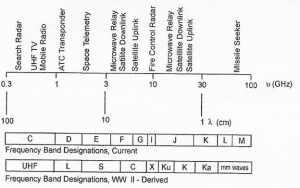
Source: (Nielsen, 2022) (Nichols & Mumm, 2019)
Higher power Microwave devices are called LRAD (long-range area denial), not to be confused with LRAD (long-range acoustic devices). [1] The first deals with Microwaves, and the second deals with sound waves. The most recognizable device that amplifies Microwaves is the ordinary kitchen Microwave oven that we are all familiar with. It produces much less power than the LRAD.
Figure 11.2: Kitchen Microwave

Source: Courtesy of Author (Mai)
Figure 11.3: Inside of ordinary kitchen microwave oven
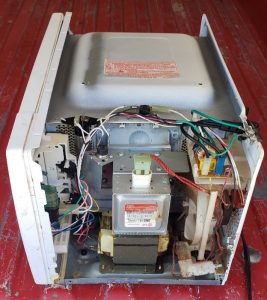
Source: Courtesy of Author (Mai)
Figure 11.4 Magnetron and set up Transformer

Source: Courtesy of Author (Mai)
Microwaves interact with water molecules. Electromagnetic Radiation consists of photons and an associated sinusoidal varying electric field. Water molecules are dipolar, meaning that they have oppositely charged ends, making them asymmetric.
When a microwave interacts with water, the energy attempts to flip the water molecule to align with the varying magnetic field. The magnetic field changes or flips at approximately 2.5GHz/sec in a microwave or 2.5 billion times per second. At this rate, the flipping of the water molecule creates friction, causing heat to be transferred to the surrounding nonresponsive material and thus cooking your food. About the microwave oven, an LRAD operates at a much higher energy of 80-100GHz. The microwave oven can penetrate deeper within a material because the number of molecules and the amount of power allows for this to happen. But it would never act well as a weapons system because the waves are dispersed over a relatively short distance.
However, a military, active denial system operating at a much higher power keeps the energy collimated into a beam so it can act upon the surface of an object. Therefore, with smaller energies and larger wavelengths, the energy is deposited deeply into the material, making a Microwave oven-good for cooking compared to a higher power and shorter wavelength that tends to deposit the majority of energy on the surface of a material. This is good for a weapons system where the target is the skin’s surface with highly concentrated nerve endings. Also, the shorter wavelength of an LRAD can be better focused and sent further downfield.
Figure 11.5 ADS (Active Denial System) / LRAD (Long Range Active Denial)
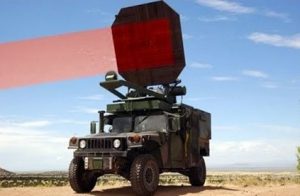
Source: (ADS / LRAD, 2022)
Frequency is expressed in Hertz, one cycle every second. Microwaves are expressed as having frequencies between 300 million cycles per second (megahertz) and 300 billion cycles per second (gigahertz), making them high-frequency radio waves. Microwaves have numerous useful civil applications. For example, Radar (radio detection and ranging) uses microwaves with higher frequencies and shorter wavelengths. Their shorter wavelengths allow them to transmit them in a specific direction as a beam. They travel in a straight line until reflected by an object they encounter. For example, if directed at a plane, the radar’s reflected waves detect its aircraft type, direction, and speed. Using radar allows traffic controllers at airports to direct aircraft traffic. Stealth aircraft have a low radar signature, degrading the radar’s ability to detect and track the aircraft, and may appear to resemble a bird more closely on a radar screen. Stealth aircraft achieve a low radar signature by reflecting the radar beam in directions that are not detectable or by absorbing a portion of the radar beam.
Back to Microwave Ovens
Most kitchens have a microwave oven. Microwave ovens operate at 2,450,000 cycles per second (2,450 megahertz. (Monte, 2021) Microwave ovens work by channeling the microwave beam directly at the food. The molecules composing the food absorb the beam’s energy, making the fat and water molecules vibrate. This vibration causes friction, which generates heat and increases the temperature of the food. This increase in temperature cooks the food. You can look inside the microwave because the microwave door contains a plate of glass covered by a metal mesh screen. The screen reflects the microwaves because the mesh holes, too small for microwaves to escape, are large enough to allow visible light to pass through and enable you to see what’s cooking inside besides these typical microwave applications, many more, including industrial applications. Let us move on to microwave weapons.
Definition of a Microwave Weapon: a device that damages a target by emitting focused microwaves. The critical word in this definition is “damage.” (Monte, 2021)
While radar and microwave ovens focus microwaves on a target, their intent is not to damage. A critical attribute of Microwave Weapons, unlike laser weapons, is that they suffer little to no distortion by weather or atmospheric conditions. They can easily penetrate a fog. By contrast, laser weapons find it challenging to penetrate fog. High-energy microwave weapons have a long reach, typically measured tens to hundreds of miles. These weapons can damage humans, electronic systems, and fuel. (Monte, 2021) For example, the Havana Syndrome,[2] [3] Similar to the Moscow Signal, left some victims with permanent brain damage.
Figure 11.6: US embassy in Havana, Cuba

Source: (US Embassy in Havana, Cuba, 2021)
Electronic systems exposed to a pulse of high-energy microwaves will suffer catastrophic failure, even if the electronics are off or disconnected from a power source. The microwave pulse induces surge currents in the electronic circuits, causing damage. High-energy microwaves can also damage the fuel of a missile, truck, or any other platform. The damage results when the microwaves heat the fuel to the point it explodes. (Monte, 2021) Like lasers weapons, microwave weapons will continue to function as long as they have sufficient power. Another common point is that directed-energy weapons can replace conventional weapons that use gunpowder, thus removing the need to supply and store dangerous ammunition for the replaced armament. (Monte, 2021) For example, if a bomb hits the magazine of a warship, the bomb’s explosion will trigger the magazine to explode and may sink the ship. Thus, by replacing conventional weapons, directed-energy weapons can significantly improve safety.[4] (Monte, 2021)
U.S. Microwave Weapons Antipersonnel Microwave Weapons
There are two types of antipersonnel microwave weapons, neurological and biological.
Neurological Microwave Weapons
These weapons attack the human nervous system, typically the brain. Projecting low-frequency microwaves at humans is, by definition, a neurological microwave weapon. Although it is nonlethal, it can result in permanent brain damage. (Monte, 2021) The United States is silent about deploying or using this type of weapon; however, DARPA built one to study its effects on a monkey (in the Pandora Program). (L, 2019) Other interesting DARPA projects include the codenames Hello, Goodbye, and Good Night.
Hello, Goodbye, and Goodnight
What are these DARPA projects?
“Development of the system began in the 1990s with the Air Force’s efforts to explore the biological effects of microwaves.
A project code-named Hello studied how to modulate the clicking or buzzing sounds produced by microwave heating in the inner ear to produce psychologically devastating ‘voices in the head.’
‘Goodbye’ explored the use of microwaves for crowd control. And ‘Good Night’ looked at whether they could be used to kill people.” (L, 2019)
The PANDORA Project
“New Research Program in the US — The Pentagon wants to know more about how your body cells use electromagnetic radiations to talk to each other. A new research program will explore:
Whether electromagnetic waves are purposefully transmitted and received within or between cells and, if so, to leverage those insights not just for biosystems but also for communicating in cluttered electromagnetic environments.” (L, 2019)
Many of these ideas about cell-to-cell signaling are not new. Twenty-five years ago, Ross Adey described how cells “can whisper together across the barrier of cell membranes.” Such messages, he believed, could control complex biological processes. Further, Adey maintained that external EM radiation could also activate, overwhelm, or muddle such processes. These are more commonly known as non-thermal effects. Back in the 1960s, Adey worked on a top-secret DARPA project called Pandora to investigate the effects of low levels of microwave radiation. (L, 2019)
The project was initiated after the U.S. government discovered that the Soviets were beaming microwaves at its embassy in Moscow. (RadioBio: DARPA To Explore Cell-to-Cell Communications, 2017)
Biological Microwave Weapons
These weapons attack the body in various ways, such as causing skin irritation or the sensation of hearing loud sounds or voices. (Monte, 2021)
Skin Irritation
The U.S. military has developed and deployed a microwave weapon termed the Active Denial System. According to Phys.org, “A sensation of unbearable, sudden heat seems to come out of nowhere; this wave, a strong electromagnetic beam, is the latest non-lethal weapon unveiled by the U.S. military.” (Rabechault, 2012)
The military is intentionally not calling this a microwave weapon because it judges the average person will equate this with using a microwave oven. After conducting interviews with U.S. Marine colonel Tracy Taffola, the director of the Joint Non-Lethal Weapons Directorate, and Stephanie Miller, who measured the system’s radio frequency bio-effects at the U.S. Air Force Research Laboratory, Phys.org learned the following information: The system output frequency is 95,000,000,000 cycles per second (95 gigahertz) and is superficially absorbed by the skin, leading to the target’s immediate instinct to flee (hence its name, Area Denial System or ADS). Its reach, or range, is a thousand meters (0.6 miles). (Rabechault, 2012)
Figure 11.6A Two styles of US Marine Corps trucks are seen carrying the Active Denial System, March 9th, 2012, at the US Marine Corps Base Quantico, Virginia. The non-lethal weapon projects a strong electromagnetic beam up to 1000-meters
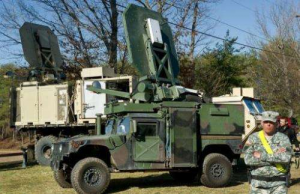
Source: (Rabechault, 2012)
The U.S. military considers the system its safest nonlethal capability, having exposed 1,100 people and resulting in only two people suffering injuries that required medical attention to recover fully. The U.S. military deployed it in Afghanistan in 2010 but did not use it in operation. (Monte, 2021)
Frey Effect Weapons
These microwave weapons cause people to perceive they hear a sound. In 2003 WaveBand Corporation received a contract from the U.S. Navy to design a microwave weapon for military crowd control. According to New Scientist, the project transitioned to Sierra Nevada Corporation in 2008. Its product MEDUSA (Mob Excess Deterrent Using Silent Audio) is a microwave ray gun that causes people to perceive they hear painfully loud booms. (Hambling, microwave-ray-gun-controls-crowds-with-noise, 2008) The Living Moon reports, “MEDUSA involves a microwave auditory effect ‘loud’ enough to cause discomfort or Microwave Weapons incapacitation.” (Hambling, Microwave ray gun controls crowds with noise, 2008) Unfortunately, much like the Moscow Signal and the Havana Syndrome.
Some experts suggest MEDUSA may also cause “neural damage.” In addition to the victim’s appearing to hear noises and voices, the weapon may disrupt a person’s balance, cause fevers, and trigger epileptic-type seizures. The U.S. Army, and potentially the U.S. Secret Service, use medusa or similar technology and the technology described in another U.S. Patent. In 1996 the U.S. Air Force filed a patent for a “method and device for implementing the radio frequency hearing effect.” (USAF, 1996-12-13 applied) The patent delineated a device that would cause victims to perceive hearing voices. The U.S. Patent and Trade Office granted the patent in 2002. It works fundamentally: The inner ear has sections filled with air and fluid vulnerable to microwaves at specific frequencies. The human head acts as an antenna for microwaves. When the head receives those microwave signals, they slightly heat those inner-ear sections, causing them to expand and shift. The human body does not feel the heat or expansions, but the ear records the shifts. The ear’s design requires it to interpret the variations as sound, which is a function of the microwave frequency. (USAF, 1996-12-13 applied) Modulating the frequencies (i.e., changing the shifts in the inner ear) makes it possible to form words. (Monte, 2021) The volume at which the sound is heard is a function of the power of the microwaves. Unfortunately, a patent has to describe how the technology works sufficiently to guarantee the patentee’s intellectual property rights. This one provides insight into how to build this device. Through the Invention Secrecy Act of 1951, the U.S. government can prevent a patent’s disclosure. (Monte, 2021) This weapon may induce mental illness or cause a person to act irrationally. Although it is a grim reality, we need to acknowledge these types of microwave weapons exist. Neurological and Frey effect weapons are extremely concerning, given that they have the potential to cause hearing sounds. Typically, hearing odd sounds or voices is a sign of mental illness. However, knowing the Frey effect microwave weapons exist, a person suffering these sensory effects may not be mentally ill but the victim of a microwave attack. (Monte, 2021)
Figure 11.7: Frey Effect
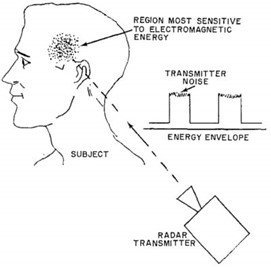
Source: (Frey Effect, 2022)
CHAMP
U.S. military personnel responsible for Frey effect weapons likely also know about it. Currently, no law prohibits their use against enemy combatants or anyone else, including you. Microwaves can damage electrical and electronic systems. (Monte, 2021) On May 19, 2019, the Daily Mail published an article titled “U.S. Air Force Has Deployed 20 Missiles That Could Zap the Military Electronics of North Korea or Iran with Super Powerful Microwaves, Rendering Their Military Capabilities Virtually Useless with no collateral damage.” (U.S. Air Force-deployed-20-missiles-fry-military-electronics-North-Korea-Iran, 2019) According to the article, known as the Counter-Electronics High Power Microwave Advanced Missile Project (CHAMP), the missiles were built by Boeing’s Phantom Works for the U.S. Air Force Research Laboratory. The microwave weapons can be launched into enemy airspace at low altitudes and emit sharp pulses of high-power microwave energy that disable electronic devices targeted. Mary Lou Robinson, the High-Power Microwave Division of the Air Force Research Lab chief, has confirmed to DailyMail.com that the missiles are now operational and ready to take out any target. While North Korea or Iran may attempt to shield their equipment, U.S. officials doubt that would be effective against CHAMP.
Figure 11.8: CHAMP

Source: (USAF, 2019)
The project has been advancing secretly ever since the Air Force successfully tested a missile equipped with high-powered microwave energy in 2012. This report would mark a significant milestone in the deployment of microwave weapons, but the Daily Mail is usually considered a questionable source. However, there is some evidence that the report may be valid. [5] Ronald Kessler, a former Washington Post and Wall Street Journal investigative reporter wrote the article. He is also the New York Times best-selling author of The Trump White House: Changing the Rules of the Game. (Kessler, 2018)
Boeing’s website also lists a 2016 news release describing the same weapon. Here is an excerpt: “During the test, the CHAMP missile navigated a pre-programmed flight plan and emitted bursts of high-powered energy, effectively knocking out the target’s data and electronic subsystems. CHAMP allows for selective high-frequency radio wave strikes against numerous targets during a single mission.” (Fightersweetstaff, 2016) In addition, CNN reported in 2015 that the “Air Force confirms [it has an] electromagnetic pulse weapon.” Boeing has developed a weapon that can target and destroy electronic systems in a specific building.” In the report, CNN used the phrase “Boeing ‘Lights Out’ Weapon,” which Boeing used in a press release that included interviews with Keith Coleman, the champ program manager, and Peter Finlay, the Air Force Research Laboratory’s CHAMP lead test engineer. (CNN, 2015) With CHAMP shrouded in secrecy and the U.S. Air Force silent on its deployment, we must treat the Daily Mail story with a skeptical eye. However, if this advanced missile is deployed, it is a superior electronic warfare weapon because it destroys, rather than jams, electronics. (Monte, 2021)
Jamming only temporarily affects systems, which can recover when the attack ceases. If the U.S. military were deploying CHAMP, it would be a game-changer, as these cruise missiles can be released and attack an adversary without detection. Since CHAMP is a ground-hugging cruise missile, an adversary likely would not detect it via radar. Without the necessary electronic systems to respond, an adversary would only know that its ability to counterattack was inoperable. It also might not be capable of determining the nation responsible for its mysterious power loss. CHAMP’s pulse would render an adversary’s command center useless, with its computers fried, communications salient, and lights out. Thus, the system’s capability has the potential of rendering the mad doctrine void. Drone Defense Microwave Weapon Swarming tactics are a reality, and potential U.S. adversaries use them. On July 22, 2019, Iran seized two merchant vessels, a British oil tanker and an unidentified foreign oil tanker, using swarm tactics. Reuters states, “Instead of trying to match the U.S. military weapon-for-weapon, Iran deploys large numbers of relatively unsophisticated systems on land, at sea, and in the air. The idea is to overwhelm American forces, much like a single bee is a nuisance to a human being, but a swarm of them could prove lethal.” (Monte, 2021) In 2002, the U.S. military launched the war game Millennium Challenge, the most extensive simulation ever held, involving 13,500 people. It ran from July 24 to August 15 and included live exercises and computer simulations. Its purpose was to simulate a war with Iran set in 2007. According to the New York Times, “The upshot was that the enemy ‘sank’ much of the American fleet as the exercise opened.” Given the might and sophistication of the U.S. Navy, it is reasonable to question how this is possible. The answer is one word, swarming! In the war game, Iranian forces deployed swarms of speedboats armed with cruise missiles, rockets, torpedoes, sea mines, machine guns, and shoulder-fired surface-to-air missiles. (Monte, 2021) In addition, the Iranians deployed shore-based missiles also le of swarming the U.S. fleet. To the surprise of the war game’s participants, the swarming was effective and inflicted significant damage to U.S. Navy warships. The U.S. military uses these war games to test equipment and concepts. (Monte, 2021) The U.S. Navy’s goal is to make these vessels more lethal. In addition to conventional armaments, it appears to be leaning toward directed energy weapons. While the navy is finding lasers are effective against speedboats, Raytheon’s advanced high-power microwave system is proving itself a more effective drone killer. In 2018, according to the company’s website, “Raytheon’s high-power microwave system engaged multiple UAV [unmanned aerial vehicle] swarms, downing 33 drones, two and three at a time.” (Monte, 2021) (Raytheon, 2018). The Microwave beam disrupts the drone’s guidance system and can attack the entire swarm, downing multiple drones at a time. In the same test, Raytheon’s high-energy laser system proved lethal against drones but zapped them simultaneously. Microwave Weapons While the navy is still testing to determine how it will arm its littoral combat ships, directed-energy weapons appear to be in the running. For example, in 2020, the navy stated it would begin testing the effectiveness of laser weapons aboard them. Microwave weapons are far less sensitive to atmospheric disturbances than lasers, making them a more robust all-weather weapon. Microwave weapons appear better suited than lasers against drone swam attacks. In combination, they would remove the need for the Phalanx machine gun, the U.S. Navy’s close-in weapon system that serves as a last-ditch defense against missiles and uses gunpowder, potential liability a, and the use of short to intermediate-range missiles against drones and missiles. Laser and microwave weapons also provide a low-cost, unlimited, and continual defense against missile, drone, and speedboat swarms; short- to intermediate-range missiles do not. The most crucial phrase in the last sentence is “low cost, unlimited, and continual.” As long as the navy supplies power to these directed-energy weapons, they will continue to work, and a typical laser shot costs about a dollar. By contrast, short- to intermediate-range missiles are expensive, typically costing hundreds of thousands of dollars, and a warship can only carry a finite number of them. (Monte, 2021) Let us now examine the microwave weapons of two of the United States’ potential adversaries, Russia and China.
Russian Microwave Weapons
Russia has probably developed a low-frequency microwave weapon. It is also likely the Russians used it against U.S. Embassy staff in Moscow (1953), Cuba (2017), and China (2018). They do not claim to have such a weapon, but significant evidence says they do. In 2009 Russia and Cuba signed a strategic partnership alliance to expand cooperation in agriculture, manufacturing, science, and tourism. While there were no public statements regarding their rekindling of Cold War-era military ties, Russia needed military allies, and Cuba needed financial help. Cuba is also conveniently located only about a hundred miles from Florida. These points suggest Russia and Cuba would secretly engage in a military alliance. As noted previously, the Cuban government, armed with a Russian microwave weapon, possibly perpetrated the attack on the U.S. Embassy personnel in Havana. Russia’s ties to Cuba and China may have enabled it to trade this microwave weapon for the secret information about the United States gained through the weapon’s use. Russia is aware that the United States is developing microwave weapons. However, the Russian economy and its corrupt government may hamper its indigenous development of high-power microwave weapons through either espionage or its relationship with the Chinese, whose history demonstrates an ability to hack U.S. military secrets. “Russia has just announced their creation of a microwave gun to knock drones and warhead missiles out of the air from 10 kilometers [about six miles] away!”[6] In typical Russian fashion, the details of the weapon remain secret. Officials reportedly scheduled a private weapon demonstration during the Russian Defense Ministry’s Army-2015 expo. Suppose Russia’s claims are valid, according to Military & Aerospace Electronics. It could “complicate U.S. military strategic planning, which has relied heavily on precision-guided munitions, GPS navigation, and tactical battlefield networking for the past quarter-century.” While Russia exaggerates its new weapons’ capabilities, this report is four years old. Russia could have engineered it to be a potent microwave weapon even with typical development issues. According to a 2010 research report by Robert J. Capozzella, “As for the anti-aircraft systems, Russia is researching and trying to sell the Ranets-E and Rosa-E. The first is a point defense system designed to target the electronics of modern aircraft; the second is a defensive aircraft system that targets enemy aircraft radar. however, these are still in development based on the advertised beam output; [sic] their range is promising against unshielded systems but otherwise limited.” (Capozzella, 2010) As part of the sale, Russia requires additional development investment from the buyer, but the Russian military leadership intends to build and sell microwave weapons. Capozzella’s report is more than a decade old as of his writing. Meanwhile, the Russians may have secured the necessary development funding and perfected these weapons. Unfortunately, Russia’s “iron curtain” still hides secrets from the free world. Its leadership momentum in nuclear weapons lasted only four years against the Soviet Union, which detonated its first atomic weapon in 1949. (Monte, 2021) (Capozzella, 2010)
Chinese Microwave Weapons
China is actively building microwave weapons that appear identical to the U.S. military’s champ and Active Denial System. Rather than keeping these weapons secret, the Chinese are touting their capabilities. Let us examine these weapons. China’s CHAMP, like Microwave Weapon: According to a Popular Science report in 2017, “For over six years, Huasixg Wenhua and his team at the Northwest Institute of Nuclear Technology in Xi’an have been working on a potent microwave weapon. This one, which recently won China’s National Science and Technology Progress Award, is small enough to fit on a workbench, making it theoretically portable enough for land vehicles and aircraft.” (Singer, 2017) China’s leadership believes that directed-energy weapons will dominate warfare by midcentury, fueling this investment level. China’s Microwave Active Denial System (CMADS): This system appears identical to the U.S. Active Denial System, even sharing its name. According to the state-run Chinese tabloid Global Times, “China is developing a non-lethal weapon system based on microwave radar technology. (Perwakilan Press, 2019) The project’s chief engineer said it improves the country’s counter-terrorist and land and maritime border defense capabilities. [It is] officially named Microwave Active Denial System, works by shooting millimeter microwaves at targets, which can cause the pain nerve under the skin to ache in a bid to effectively halt the objective’s [a person’s] violent actions and disperse targets [crowds].” (Perwakilan Press, 2019)
Radiation-Hardened Electronics and System Shielding Nuclear weapons can create high radiation environments. Those environments give rise to electromagnetic radiation, which can fry electronics. Since U.S. military hardware must work in high radiation environments, such as in outer space or during a nuclear detonation, the electronics must be hardened, and the cables shielded. The phrase “radiation-hardened systems” typically means the entire system is radiation-resistant. This level of radiation resistance requires the electronics to be radiation tolerant or shielded, and that shielding must also protect the interconnections. If any portion of the system is vulnerable, it may lead to a catastrophic failure. For example, during a microwave or EMP event, even one interconnection without shielding can send high electrical surges throughout the entire system. Radiation-hardened electronics are components whose design and manufacture allow them to withstand high radiation environments, such as those found in outer space or nuclear environments. Again, though, the radiation levels and the duration of exposure to which they were exposed are classified. Honeywell’s Solid-State Electronics Center was one of the few integrated circuit foundries in the United States capable of producing radiation-hardened electronics. These integrated circuits are challenging to design and produce. Their cost reflects that difficulty. Another essential way to protect electronics and interconnections is by shielding, which typically involves using metals to form a Faraday cage or a continuous metal enclosure.
A Faraday cage makes it difficult, but not impossible, for microwave or EMP to penetrate its interior. Therefore, putting your smartphone in a metal can will provide some shielding from an EMP. How militaries shield their systems is, in practice, complex. Various materials can absorb radiation or reflect it. Military system designers also have to balance weight restrictions versus radiation protection. For example, while lead is generally an excellent radiation shield, its weight makes it challenging to use for space applications. Launching heavy satellites into space is extremely difficult. (Monte, 2021)
Unmanned aerial vehicles (UAVs) are integral to how business and people conduct their daily operations and lives. Such things as providing images, deliver and needed medicines to remote areas, and military support from intelligence gathering and tactical battlefield weapons. They are effective at providing defense systems previously unavailable on the battlefield. Unmanned aircraft, low cost, have become a serious hazard worldwide if used maliciously. Even with strict limitations on the commercial use of unmanned aerial systems, savvy criminals can be a huge threat in protected airspace. They can disrupt air traffic. In U.S. airspace alone, the Federal Aviation Administration receives more than 100 reports of drone incidents each month. (Mayser, 2021)
DETECTING AND DISABLING DRONES
To effectively counter the threat, early warning is critical. Most commercial counter unmanned aerial vehicle (CUAV) systems can block the radio link between the remote-control transmitter and the drone receiver to prevent the aerial vehicle from penetrating a no-fly zone; to do so, they must disable the radio communication. (Nichols & al., 2020) Finding the UAV to protect against is important. Enhanced CUAV technology can detect commercial drone activity and automatically classify the type of drone signal. It can determine the drone’s direction and its pilot and, on command, disrupt the radio control link to prevent the drone from reaching its target. (Nichols & al., 2020) (Mayser, 2021)
Drones are controlled with an uplink signal from the remote control to the drone using the frequency hopping spread spectrum (FHSS). WLAN is used as a standard for control also. Signals transmitted to the drone’s ground (i.e., the downlink) are typically FHSS, wideband or WLAN signals. (Mayser, 2021) To detect the drone’s radio communications (RC) signals, highly sensitive antennas and monitoring receivers are needed. Under ideal conditions, commercial off-the-shelf RCs can be detected up to 7 km and 5 km for drones such as the DJI Phantom 4. (Mayser, 2021)
Figure 11.9 DJI Phantom 4
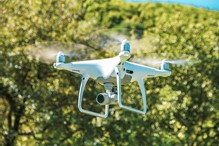
Source: (DJI Phantom 4, 2022)
CUAV systems use radars sensors for detection and require line-of-sight (LOS) to the drone. Other sensors, such as acoustic, are limited by range and environmental factors. Monitoring the RC links is the only method that enables a drone to be detected when switched on. RC activity can be recognized even before a drone takes off, as drones require preflight checks. During this time, the RC is active and can be detected. With this early warning, CUAV systems using RC monitoring provide a key advantage to any multi-sensor CUAV system – more time to react. Also, determining the drone pilot’s location from the RC signal enables security personnel to deploy quickly, with a greater chance of finding and apprehending the pilot. (Mayser, 2021) (Nichols & al., 2020)
DRONE DETECTION RADAR
Figure 11.10: Analyzing a Radar Pulse Using an R&S Spectrum Analyzer
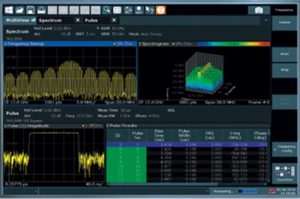
Source: (Image Analyzing a Radar Pulse Using an R&S Spectrum Analyzer, 2021)
Because of a drone’s small size, low altitude, and slow speed, reliably detecting it is a challenge for radar. Radar sensors must quickly scan large volumes with great sensitivity, eliminate nuisance alarms such as birds and reliably discriminate UAVs from ground targets (see Figure 11.10). When designing a drone detection radar, the key design considerations are:
- Radar operating frequency
- Scan coverage and response time
- Resolution and environmental considerations
- Classification capability.
The operating frequency is determined by considering propagation efficiency, the scanned terrain, environment, desired detection range, and minimum detectable radar cross-section. With many applications requiring 360-degree azimuth coverage, the scanning requirements range from monitoring large spatial volumes with high refresh rates to illuminating contacts to classify and initiate countermeasures. Further classification using secondary sensors such as optical or audio requires accurate information regarding range, bearing, and height, which often demands complex 3D capabilities. To determine the performance requirements for the component, module, or subsystem, the appropriate solutions should cover all relevant measurements for power output, antenna pattern, spectral emission mask, interface performance, and the phase noise of phased-locked loops in the microwave signal generator. (Mayser, 2021) (Nichols & Mumm, 2019)
DETECTING DRONES USING RC
To detect FHSS-controlled drones using their RC signals, the CUAV system should compare measured signals with a library of drone profiles. With automatic online hopper analysis, the system can identify signal parameters such as hop length, symbol rate, and modulation type, which enables classifying the drone. The CUAV system can force the drone to safely fail by disrupting the control signal with a “smart,” adaptive, low-power countermeasure. (Mayser, 2021) A wideband smart exciter can selectively jam only the detected FHSS signals and disrupt the drone’s uplink. With WLAN-controlled drones, an RC-based CUAV system using sectorial WLAN antennas for directional information can disrupt the WLAN link between the remote control and the drone. (Mayser, 2021) (Nichols & al., 2020) (Nichols & Mumm, 2019)
Other CUAV solutions use a barrage jammer, spreading power over the complete frequency band. This requires high output power and disrupts all active transmissions in the frequency band, not only the control signal for the drone.
In addition to detecting and jamming the drone, the CUAV system should provide direction-finding information: the operator’s direction from the direction of the RC uplink signal and the drone’s direction from the telemetry or video downlink signal.
DETECTION AND JAMMING RANGES
Figure 11.11: Theoretical Detection Range Without Noise

Source: (Image- Theoretical Detection Range Without Noise, 2021)
Figure 11.12: Theoretical Detection Range With Noise, e.g., In An Urban Environment
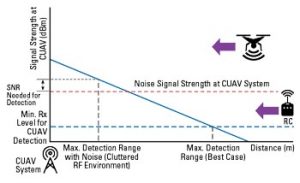
Source: (Image -Theoretical Detection Range With Noise, e.g., In An Urban Environment., 2021)
Figure 11.13: Theoretical jamming range
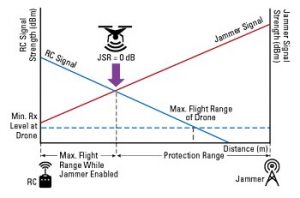
Source: (Image – Theoretical Jamming Range, 2021)
.
For drone detection, the received RC signal strength at the CUAV receiver must be equal to or greater than the receiver (Rx) sensitivity or minimum signal-to-noise ratio (SNR), i.e., the minimum level. The SNR depends on the actual RF environment and changes continuously. A cluttered RF environment, for example, will reduce the detection range. To classify the drone type, a minimum Rx level must be received by the CUAV receiver. This minimum level is specific to the type of drone and depends on the FHSS modulation of the RC signal and the overall noise perceived by the detector. Figure 11.11 illustrates the maximum detection range in an environment with minimal noise. The detection range is substantially reduced in an electromagnetically noisy environment like a city (see Figure 11.12). (Mayser, 2021)
A drone is controllable when the RC signal strength at the drone receiver is greater than the minimum Rx level. If a jamming signal is also present and greater than the RC signal power at the drone – when the jamming-to-signal ratio (JSR) is ≥ 0 dB – the drone is typically no longer controllable by the pilot. However, this depends on the coding scheme of the remote control (see Figure 11.13). The greater the JSR, the higher the probability the CUAV can disable the drone.
Figure 11.14: Jamming ratio for CE-compliant remote control operating in the 2.4GHz ISM band
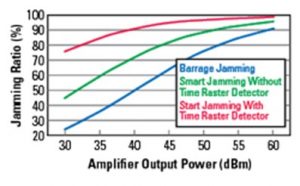
Source: (Image -Jamming ration for CE-compliant remote control operating in the 2.4GHz ISM band, 2021)
Figure 11.14 illustrates a jamming test using a CE-compliant remote-controlled drone with the uplink in the 2.4 GHz band. The jammer uses a power amplifier connected to a Rohde & Schwarz UHF omnidirectional antenna with a 10 m cable. Three types of jamming signals were evaluated: barrage jamming, smart jamming without a time raster detector, and smart jamming with a time raster detector. The plot shows the jamming ratio versus amplifier output power for the three scenarios, showing smart jamming is more effective than barrage jamming. (Mayser, 2021)
CUAV manufacturers often claim long ranges and precise jamming distances; however, these figures are not precise. The jamming range will depend on the ratio of the jammer signal strength to the RC uplink signal strength at the drone, i.e., the JSR. (Nichols & al., 2020) Under realistic conditions, field trials have repeatedly shown the range claims of CUAV system suppliers are often not verifiable. Ironically, the performance of systems claiming relatively short ranges, such as 2 km, is often similar to systems claiming longer ranges, such as 15 km. What is a realistic detection range? In some scenarios, systems will achieve very long detection ranges, usually the values shown in the technical specifications of CUAV systems. Yet these “best case” circumstances do not represent the performance in typical rural or urban deployments. Environmental conditions, such as RF noise or the relative permittivity of the ground, influence detection and jamming ranges. The environment changes constantly, and the measured detection and jamming ranges will often vary with every measurement. (Nichols & al., 2020) (Mayser, 2021)
To achieve exceptionally long detection ranges, the Rx antenna of the CUAV system should be elevated, and the terrain between the CUAV Rx antenna and the RC Tx antenna should have low relative permittivity, such as a freshwater lake at 0°C water temperature. The first, second, and third Fresnel zones should be free of obstacles, and the RF environment should have low noise – thermal and other transmitters. The RC signal frequency should be in a low-frequency band, the signal should have high output power, and the antenna cables should be short. Choosing antennas with higher directionality will increase the antenna gain. (Mayser, 2021)
DEPLOYING CUAV SYSTEMS
As CUAV systems depend on the application environment, they must be adapted to each scenario to achieve the optimum detection and jamming ranges. The distance ranges published by manufacturers only indicate how to optimize the CUAV system for the application. (Mayser, 2021) (Nichols & Mumm, 2019)
Under optimized conditions, the R&S ARDRONIS CUAV system can detect an RC signal 7 km. Detection ranges measured in urban or rural environments are shorter because of lower SNR, non-optimized antenna sites, and other factors. Table 11.1 shows several environments and the typical ranges in the ARDRONIS system that can detect a CE-compliant RC output signal at 2.4 GHz, comparing urban, rural, and low noise environments with LOS and non-LOS between the drone and CUAV. The R&S ARDRONIS system uses a wideband smart exciter to jam remote-controlled transmission, using an FHSS signal matching the detected type of drone signal. Its jamming range will depend on the remote control’s output power and the system’s detection range (see Table 11.2). (Mayser, 2021)
Table 11.1 Shows Several Environments and the Typical Ranges In The ARDRONIS System
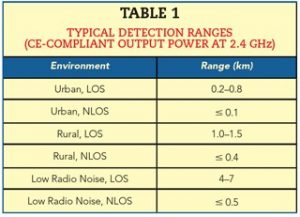
Source: {Table 1} Courtesy of (Mayser, 2021)
Table 11.2 Typical Jamming Ranges
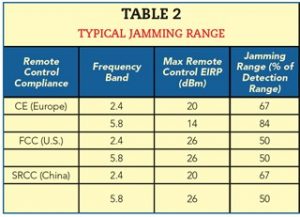
Source: {Table 2 } Courtesy of (Mayser, 2021)
Determining what detection and jamming ranges are acceptable for a specific application depends on the following considerations:
- What time is needed from detection to reaction? The earlier a drone is detected, the more time for reaction.
- After detecting a drone, what action is required? Activating a jammer is very fast. However, finding and apprehending the pilot with security personnel will take more time.
The longer the required early warning time, the more important short detection and jamming become. (Mayser, 2021)
CONCLUSIONS
From popcorn to crowd control, from aircraft detection to CUAVs, Microwaves play an important part in each of these areas of modern society in their function and protection or its destruction. All CUAV systems are subject to the laws of physics. The detection range is determined by the relative location of the RC and CUAV system, the Tx power of the RC, and the physical and RF environments. The jamming range is determined by the relative location of the drone and CUAV system, the Tx power of the jammer, and, again, the environment. The required detection and jamming ranges depend on the application scenario for the CUAV system. Proper planning for each scenario is necessary before the CUAV system can be defined and deployed. (Mayser, 2021)
Managing Editor’s OPINION
It is clear that sUAS – moderate UAS may not be useful to deliver Microwave based weapon systems. Limitations on weight, speed, cost, power, and maneuverability are negatives. Our discussion of the USA, Russian, and previous Chinese PUBLIC / OPEN research suggests that large UAS capable of extended distances, heavy payloads, and survivability with stealth-based protections may be feasible to deploy Microwave weapons. Effective Microwave defenses against SWARMS exist from ground-based systems. (Nichols & al., 2020) However, much of the research on UAS and the ability to deliver Microwave weaponry is CLASSIFIED and not available for OPEN / Public publication. For the time being, Microwave UAS weapons delivered by small or moderate-sized drones remain in the land of conjecture and popular science fiction. [7]
Bibliography
ADS / LRAD. (2022, April 17). Retrieved from http://terasense.com: http://terasense.com/wp-content/uploads/2019/05/ADS-1.jpg
Capozzella, L. R. (2010, Feb 17). HIGH POWER MICROWAVES ON THE FUTURE BATTLEFIELD: IMPLICATIONS FOR U.S. DEFENSE. Retrieved from www.airuniversity.af.edu: https://www.airuniversity.af.edu/Portals/10/CSAT/documents/researchpapers/2010/bh2010_capozzella.pdf
CNN. (2015, May 25). boeing-electromagnetic-pulse-weapon. Retrieved from www.cnn.com/videos/: https://www.cnn.com/videos/us/2015/05/25/orig-boeing-electromagnetic-pulse-weapon.cnn
DJI Phantom 4 . (2022, April 18). Retrieved from https://images.unsplash.com/photo-1599336599646-2889f61b2349?ixlib=rb-1.2.1&ixid=MnwxMjA3fDB8MHxwaG90by1wYWdlfHx8fGVufDB8fHx8&auto=format&fit=crop&w=1170&q=80: https://images.unsplash.com/photo-1599336599646-2889f61b2349?ixlib=rb-1.2.1&ixid=MnwxMjA3fDB8MHxwaG90by1wYWdlfHx8fGVufDB8fHx8&auto=format&fit=crop&w=1170&q=80
Fightersweetstaff. (2016, December 22). boeings-champ-missile-literally-knocks-lights/. Retrieved from sofrep.com: https://sofrep.com/fightersweep/boeings-champ-missile-literally-knocks-lights/
Frey Effect. (2022, April 18). Retrieved from samim.io: https://samim.io/static/upload/akwjdawd.jpeg
Hambling, D. (2008, July). Microwave ray gun controls crowds with noise. Retrieved from thelivingmoon.com: http://thelivingmoon.com/45jack_files/03files/MEDUSA_Ray_Gun_.html
Hambling, D. (2008, July 3). microwave-ray-gun-controls-crowds-with-noise. Retrieved from www.newscientist.com: https://www.newscientist.com/article/dn14250-microwave-ray-gun-controls-crowds-with-noise/
Image – Theoretical Jamming Range. (2021, June 6). Retrieved from www.microwavejournal.com: https://www.microwavejournal.com/ext/resources/images/Figures/2021/Jun/6M29S/f4.jpg
Image Analyzing a Radar Pulse Using an R&S Spectrum Analyzer. (2021, Jun 6). Retrieved from www.microwavejournal.com: https://www.microwavejournal.com/ext/resources/images/Figures/2021/Jun/6M29S/f1.jpg
Image -Jamming ration for CE-compliant remote control operating in the 2.4GHz ISM band. (2021, June 6). Retrieved from www.microwavejournal.com/: https://www.microwavejournal.com/ext/resources/images/Figures/2021/Jun/6M29S/f5.jpg
Image -Theoretical Detection Range With Noise, e.g., In An Urban Environment. (2021, June 6). Retrieved from www.microwavejournal.com: https://www.microwavejournal.com/ext/resources/images/Figures/2021/Jun/6M29S/f3.jpg
Image- Theoretical Detection Range Without Noise. (2021, June 6). Retrieved from www.microwavejournal.com: https://www.microwavejournal.com/ext/resources/images/Figures/2021/Jun/6M29S/f2.jpg
Kessler, R. (2018). Changing the Rules of the Game. Washington: Random House.
- (2019, Feb 22). two-years-ago-darpa-to-resurrect-top-secret-pandora-project. Retrieved from inteltoday.org: https://inteltoday.org/2019/02/22/two-years-ago-darpa-to-resurrect-top-secret-pandora-project/
Mai, R. (n.d.). Images. CBRNECy Weapons Deployed from Drones. KSU, Manhattan, KS.
Mayser, T. W. (2021). Adapting Counter-UAV Systems to the Environment. Microwave Journal, 1. Retrieved from https://www.microwavejournal.com/articles/36134-adapting-counter-uav-systems-to-the-environment
Monte, L. A. (2021). War at the Speed of Light. Lincoln: Potomac Books. Retrieved from ProQuest Ebook Central, http://ebookcentral.proquest.com/lib/ksu/detail.action?docID=6460626
Nichols, R. K., & Mumm, H. C. (2019). Unmanned Aircraft Systems in the Cyber Domain, 2nd Edition. Manhattan, KS: www.newprairiepress.org/ebooks/27.
Nichols, R., & al., e. (2020). Counter Unmanned Aircraft Systems Technologies and Operations. Manhattan, KS: new prairie press #31.
Nielsen, P. E. (2022). Effects of Directed Energy Weapons. The USA.
Perwakilan Press. (2019, Feb 22). china-develops-non-lethal-microwave-radar-weapon-global-times. Retrieved from perwakilan.co.uk: https://perwakilan.co.uk/2019/02/china-develops-non-lethal-microwave-radar-weapon-global-times
Rabechault, M. (2012, March 11). military-unveils-non-lethal-ray-weapon. Retrieved from phys.org/news: https://phys.org/news/2012-03-military-unveils-non-lethal-ray-weapon.html
RadioBio: DARPA To Explore Cell-to-Cell Communications. (2017, Feb 16). Retrieved from https://microwavenews.com/news-center/darpa-radiobio: https://microwavenews.com/news-center/darpa-radiobio
Raytheon. (2018, March 20). High-power-microwaves-and-lasers-defeat-multiple-drones-during-US-Army-exercise. Retrieved from raytheon.mediaroom.com: https://raytheon.mediaroom.com/2018-03-20-High-power-microwaves-and-lasers-defeat-multiple-drones-during-US-Army-exercise
Singer, J. L. (2017, Jan 27). China’s new microwave weapon can disable missiles and paralyze tanks. Retrieved from www.popsci.com: https://www.popsci.com/china-microwave-weapon-electronic-warfare/
U.S. Air Force-deployed-20-missiles-fry-military-electronics-North-Korea-Iran. (2019, May 16). Retrieved from www.dailymail.co.uk/news: https://www.dailymail.co.uk/news/article-7037549/Air-Force-deployed-20-missiles-fry-military-electronics-North-Korea-Iran.html
US Embassy in Havana, Cuba. (2021, November). Retrieved from www.aljazeera.com: Source: https://wwww.aljazeera.com/wp-content/uploads/2021/11/GettyImages-855674196-1.jpg?resize=770%2C513
USAF. (1996-12-13 applied, 2016-12-13 expired). Method and device for implementing the radio frequency hearing effect. Retrieved from patents.google.com/patent/US6470214B1/en: https://patents.google.com/patent/US6470214B1/en
USAF. (2019, May). USA_high-power_microwaves_missiles_that_destroys_electronics_not_buildings. Retrieved from www.airrecognition.com: https://www.airrecognition.com/images/stories/news/2019/may/USA_high-power_microwaves_missiles_that_destroys_electronics_not_buildings.jpg
Endnotes
[1] LRAD long-range acoustic devices are covered in Chapter 13.
[2] The Havana Syndrome is also covered under Chapter 13 as an acoustic phenomenon. The mechanisms behind the Syndrome are not fully understood but caused severe damage to US diplomats at the embassy. “Quick Analysis — If the facts are confirmed, and if a physical device indeed causes the effects, I find the microwave explanation far more likely than a sonic attack; for many reasons.” If this is indeed the case, I expect to hear nothing further in the future because the truth would send a wave of panic in the Telecom sector.”
[3] For the record — The expression “Havana Syndrome” was coined by Dr. Ludwig De Braeckeleer and appeared for the first time in a story published by the Intel Today blog on October 3, 2017. (L, 2019)
[4] This is a military argument. Terrorists have a completely different view. Safety and finances are not a concern. Expedient Damage is. “ (L, 2019)
[5] Author opinion
[6] The source is INSTAGRAM and considered unreliable/unverifiable – almost as bad as TWITTER for disinformation. (Capozzella, 2010) report pdf is verified.
[7] The Last paragraph is the opinion of the Managing Editor- ONLY.

